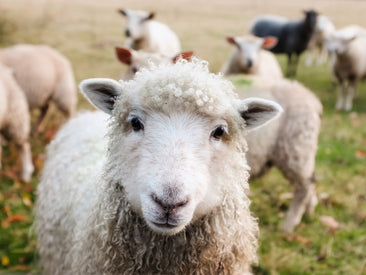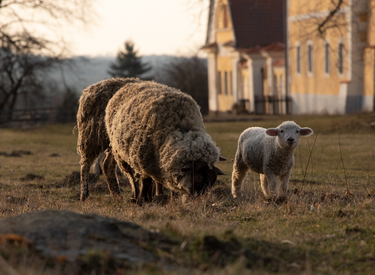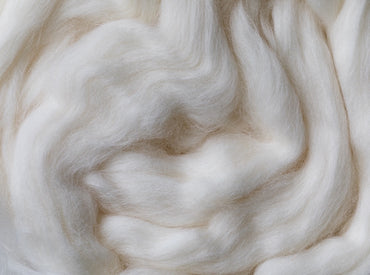Natural
Wool is a natural product that is shorn annually. It is naturally anti-microbial, wicks moisture, and regulates temperature - keeping you warm in winter and cool in summer.
In this guide we’ll example all the major pillow types and the differences between each. Our considerations look different than other lists, which typically just include price and comfort. We also value health, materials used, and sustainability when it comes to pillows so those will be factors as well in our analysis. Health is a consideration for us because of our own story. When we were starting a family, we wanted to make sure the things in our house were as least toxic / artificial as possible. We care about sustainability because of both the environment but also because of our family ethos of living simply. We are obviously biased towards wool pillows, but we’ll try to consider all sorts of pillows, and how they stack up.
There are a lot of pillow “types” on the market, so for this guide here are the categories we will consider:
Here are the factors we will consider along each pillow type:
Price Range
Memory foam pillows have gained popularity in recent years due to their ability to conform to the shape of the head and neck, providing excellent support. These pillows are typically priced in the mid to high range, making them an investment for a good night's sleep. They aren’t the cheapest option on the market, but aren’t the most expensive either. They are a mid market option in regards to price and you should expect to pay somewhere between ($30 - $150).
Materials Used
The materials used in memory foam pillows are artificial, they are typically made from polyurethane foam and other chemical treatments. Ever notice that chemical smell? The smell does dissipate over time. But the fact that you’re sleeping on something that is 100% synthetic shouldn’t be underestimated. We have a more detailed list of ingredients in these types of pillows here.
Comfort
You may find that memory foam isn’t the most breathable option. If you sleep hot this material, and its density might make you sweat or warm up. Since memory foam contours your head it can offer better support than traditional pillows.
Health Considerations
You typically won’t have allergies to memory foam pillows since they are artificially made. However, unlike natural materials there are other health considerations. First, foam can be home to bacteria and mold build up that can be hard to get out. Second the fact that you’re sleeping on something that’s essentially made of plastic is worth noting. You can see our post about how synthetic bedding / pillows could be leading to health issues like infertility.
Sustainability
When it comes to sustainability, memory foam pillows are not the most environmental option. They are not biodegradable and take centuries to decompose. However, some manufacturers offer eco-friendly memory foam options that use plant-based materials (but this is more common in latex pillows) and / or recycled memory foam. Examples of brands that use memory foam: Tempur-Pedic Casper Purple Tuft & Needle
Price Range
Latex pillows are very similar to memory foam in many respects. The average consumer isn’t going to really know the difference. The price range is about the same of that of memory foam, with a range depending on whether you buy from Amazon or a custom retailer ($30 - $150).
Comfort
There are little differences between latex and memory foam in regards to how they feel. You might find latex to have a more “bouncy” feel than memory foam (after all it is made from rubber). You also won’t see the classic memory foam style imprint you get on memory foam pillows. Latex pillows also aren’t recommended for those who sleep hot because of its density.
Materials Used
The materials used in latex pillows are derived from the sap of rubber trees, making them a better option than most memory foam in regards to sustainability. Like memory foam latex is also mass produced in factories (see video of that here) which drives down its cost.
Health Considerations
Health-wise, latex pillows are hypoallergenic and resistant to dust mites, and molds. However a lot of latex products on the market are mixed with bleaches and other artificial chemicals so that’s something to watch out for.
Sustainability
If the latex pillow in question is using 100% natural latex with no additives then these pillows are more sustainable than memory foam and are biodegradable. However they are still manufactured and processed so they don’t have the same qualities as wool or down in regards to sustainability.
Examples of brands: PureTree, PlushBeds, OrganicTextiles
Price Range
Natural down goose down (vs duck down) is considered one of the more luxurious bedding and pillow options. These pillows are made from the undercoating of geese and provide a lot of loft to the pillow. Natural down is also one of the most expensive pillow types with prices up to $600.
Materials Used
The two major types of down are duck down and goose down, with goose down being the pricier and higher quality of the two. There are also subsets of goose that have differences in down quality as well. However one thing to keep in mind with the materials here is that often the features are treated with artificial chemicals. There can be chemicals that bind together the down “glue down effect” and ones that have antimicrobial properties. If you want to read a scientific article on these processes, we’ve linked one here.
Health Considerations
Some people do have down allergies so these pillows aren’t hypoallergenic. And if you’re dealing with all natural down (with no chemical treatment) there is a higher likelihood that the pillow will build up mold and or dust mites.
Sustainability
Natural down pillows can be a semi-sustainable option when resourced ethically. However, no matter how these feathers are resourced it’s a traumatic experience for the goose or duck to have their feathers plucked from their bellies. This method of down harvesting is called “Live Plucking”. Not to mention that 80% of down comes from China, where there is less regulation on how down is sourced. While there aren’t stats on how many birds it takes to make a pillow it takes ~ 75 birds to make a comforter according to the Gentle World report.
Examples of brands: Pacific Coast Feather Company, Cuddledown, Downlite
Price Range
Artificial down pillows are another popular option. They often go by the sneaky name “alternative” down pillows. You see a lot of these pillows on Amazon and at big box retailers. They provide a similar loft and feel doing a good job to mimic their real counterparts. They are often a lot cheaper than real down pillows and can be found on Amazon for as low as $15.99.
Comfort
Typically these pillow feel pretty close to real down pillows just lacking a bit of loft and support you might find with a real down pillow. But mileage does vary here depending on what manufacturer you choose.
Materials Used
There are different materials used in artificial down but some of the common ones are polyesters and microfibers. These artificial materials are generally not as warm and good for insulation. This is also the reason why real down jackets are more expensive than artificial down jackets.
Health Considerations
Artificial down pillows are typically hypoallergenic, which makes them an alternative for people with allergies to real down. However because they are made from artificial, factory made materials, they possess a lot of the same health considerations that memory foam pillows have.
Sustainability
Depending on how you measure sustainability these pillows may be better or worse than real down. They don’t require hurting birds (or killing them) but they aren’t biodegradable. There are manufacturers who make recycled synthetic down pillow from recycled polyester which are better than non-recycled alternatives.
Examples of brands: Beckham Luxury Linens, Four Seasons, Basic Beyond
Price Range
Like down, wool can be sourced from different places and thus the price can vary. For example, at the Woolshire we use virgin wool from lambs who’ve never had their wool trimmed. The typical price range is between $100 - $200 for a good wool pillow.
Materials Used
Wool pillows are typically just made of wool. The naturally flame retardant and hypoallergenic properties of wool make it so that they don’t need to be treated with anything artificial. In fact, we’d be suspicious of the quality and / or authenticity of a wool pillow that is treated with something artificial.
Health Considerations
As mentioned wool is naturally hypoallergenic and its moisture wicking properties make it more resistant to mold build up which makes it quite healthy.
Sustainability
Wool is biodegradable and renewable. It also doesn’t require doing anything to an animal that isn’t good for the animal. Fun fact, if you don’t shear sheep they can suffer from wool blindness or other health issues.
Examples of brands: The Woolshire, The Wool Room.
Like with a lot of U.S. consumer products there are a ton of options when it comes to pillows. They all have different qualities and characteristics. If you want to further explore this topic we’ve written extensively on the different options in detail on our blog. Check that out here.

Wool is a natural product that is shorn annually. It is naturally anti-microbial, wicks moisture, and regulates temperature - keeping you warm in winter and cool in summer.

Wool is organic and completely biodegradable, making it an excellent material for sustainability.

Wool purifies the air by removing volatile organic compounds (VOCs) such as formaldehyde in the atmosphere.